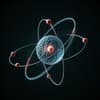Podcast
Questions and Answers
What are the common oxidation states of s-block elements and what trend is observed in their reactivity?
What are the common oxidation states of s-block elements and what trend is observed in their reactivity?
+1 and +2; reactivity increases down the group.
Explain the significance of the electronic configuration ns2np6 in noble gases and its impact on their chemical reactivity.
Explain the significance of the electronic configuration ns2np6 in noble gases and its impact on their chemical reactivity.
It indicates a completely filled valence shell, leading to their very low chemical reactivity.
What is the significance of transition elements in the periodic table?
What is the significance of transition elements in the periodic table?
Transition elements serve as a bridge between highly reactive elements in groups 1 and 2 and less reactive elements in groups 13 and 14.
Describe the electron configuration of f-block elements.
Describe the electron configuration of f-block elements.
How does the metallic character of p-block elements change across a period and what is the significance of ionization enthalpy?
How does the metallic character of p-block elements change across a period and what is the significance of ionization enthalpy?
What are the characteristics of the elements in the lanthanoid series?
What are the characteristics of the elements in the lanthanoid series?
Discuss the general trend in reactivity and ionization enthalpy as one moves down the groups of s-block elements.
Discuss the general trend in reactivity and ionization enthalpy as one moves down the groups of s-block elements.
What distinguishes d-block elements in terms of their electronic configuration and placement on the periodic table?
What distinguishes d-block elements in terms of their electronic configuration and placement on the periodic table?
What defines the third transition series in the periodic table?
What defines the third transition series in the periodic table?
How do transition elements exhibit variable valency?
How do transition elements exhibit variable valency?
Flashcards are hidden until you start studying
Study Notes
s-block Elements
- Outer electronic configuration: ns1 for alkali metals and ns2 for alkaline earth metals.
- Characteristics: Soft metals, low melting and boiling points, high reactivity due to low ionization enthalpy, and strong reducing agents.
- Common oxidation states: +1 for alkali metals and +2 for alkaline earth metals.
- Reactivity increases down the group; most form ionic compounds, except lithium and beryllium.
p-block Elements
- Consist of elements in groups 13 to 18, with the outermost electronic configuration ranging from ns2np1 to ns2np6.
- Includes metals (e.g., tin, lead) and nonmetals (e.g., carbon, nitrogen).
- Nonmetallic character increases left to right across periods; metallic character increases top to bottom within groups.
- Higher ionization enthalpies than s-block elements.
- Group 18 elements (noble gases) have stable configurations (ns2np6) and exhibit very low reactivity.
- Halogens (group 17, ns2np5) and chalcogens (group 16, ns2np4) have highly negative electron gain enthalpies, gaining one or two electrons respectively to achieve stability.
- Some elements exhibit multiple oxidation states.
d-block Elements
- Comprised of groups 3 to 12 with outer electronic configuration (n-1)d1–10ns0–2.
- Mostly metallic, high melting and boiling points, form colored complexes, variable valency, and are often paramagnetic.
- Notable elements acting as catalysts include Mn, Ni, Co, Cr, V, and Pt.
- Classified as transition elements, bridging highly reactive s-block elements to less reactive p-block elements.
f-block Elements
- Positioned below the main periodic table and characterized by the entry of electrons into f-orbitals, denoted as (n-2)f1–14(n-1)d0or1ns2.
- Includes lanthanoids (Ce to Lu, Z=58 to 71) termed rare earth elements, and actinides which start from Actinium (Z=89) to Lawrencium (Z=103).
Cation and Anion Size
- Cation size decreases as effective nuclear charge increases, leading to reduced electron-electron repulsion.
- Example: Formation of Li+ reduces the size from 123 pm to 60 pm.
- Anion size increases with more electrons due to increased inter-electronic repulsion.
Ionization Enthalpy
- Ionization enthalpy is larger than ionization energy by a small margin (≈ 6 kJ/mol) and often considered negligible.
- Alkali metals have low ionization enthalpies due to single valence electrons easily lost for stability.
- Noble gases have high ionization enthalpies due to their stable electronic configurations.
Electron Gain Enthalpy
- Defined as the energy change when an electron is added to a gaseous atom forming an anion.
- NEG (electron gain enthalpy): if energy is released during electron addition, it is negative; if energy is absorbed, it is positive.
- Electron gain enthalpies are expressed in kJ/mol or eV.
- Positive electron affinity means the resulting anion has lower energy than the neutral atom.
Summary of Key Concepts
- Electron gain enthalpy (DEG) is often used interchangeably with electron affinity, but they follow opposite sign conventions (DEG = -Ea).
Studying That Suits You
Use AI to generate personalized quizzes and flashcards to suit your learning preferences.





